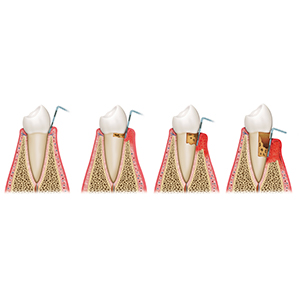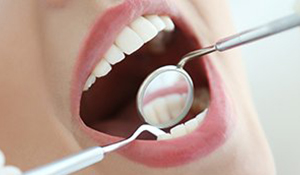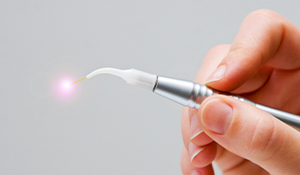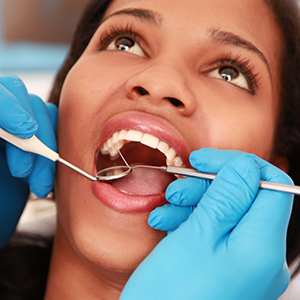


While dentists usually spend a lot of time talking about cavities, did you know that the most common dental problem in the world is actually gum disease? This infection can cause bleeding, swelling, sensitivity, chronic bad breath, gum recession, and even tooth loss in many cases. If you have red, tender gums that bleed when you brush or floss your teeth, you may have an infection called periodontal disease, also known as gum disease. The word periodontal means “around the tooth”. Periodontal disease attacks the gums and the bone that surrounds your teeth and causes the teeth to become loose. Fortunately, at Advanced Dentistry of Alhambra, we’re trained and ready to take care of your gums as well as your teeth! With meticulous exams, specialty cleanings, topical antibiotics, and even diode laser dentistry, we’re easily able to find and treat gum disease before it causes any major destruction with complete periodontal therapy in Alhambra, CA.


It is common and natural for people to develop a bit of tartar between professional cleanings. This tartar tends to start developing right around the gum line. When the tartar deposits are not regularly removed, they start to build up and move underneath the gums. This movement causes inflammation of the gums, similar to when you get a splinter under your skin. Just like when you have a cut that gets infected, your body uses your immune system to help fight off the infection. If left untreated, the gum inflammation can progress down and start to destroy the bone supporting your teeth, by forming deep pockets around the teeth. These pockets can trap more food and debris in them, and the bone loss can continue. If not treated properly, the teeth can eventually become loose and may even need to be removed.

The primary cause of gum disease is plaque and tartar buildup on the teeth below the gum line. These substances are filled with bacteria that can irritate and can break down the nearby tissues. Early stages of gum disease respond well to conservative treatments such as:

Scaling and root planning, commonly known as deep cleaning is a non-surgical procedure intended to treat gum/periodontal disease by removing bacteria and accumulations under the gum line. Scaling uses small dental instruments to scrape off all hard accumulations and bacteria that have built up under the gum, inside the pockets. Root planing smooths down the exposed root area next to the gums to prevent plaque retention and calculus deposit from building up. Most of the time we do these two procedures at the same time, followed by flushing the pockets with antimicrobial medication.

In order to make sure we get rid of all the gum disease bacteria present in a patient’s mouth, in addition to a scaling and root planing treatment, we’ll also apply a topical antibiotic. This is specifically used to clean the small spaces between the teeth and gums called periodontal pockets where bacteria like to gather and multiply. After an initial round of treatment, we’ll recommend that a patient come to see us every three to four months for regular cleanings to ensure their infection doesn’t have a chance to come back.

The diode laser can be used after the deep cleaning to disinfect the pockets. It is very effective in deep pockets that otherwise are hard to reach. A diode laser is a conservative treatment intended to prevent more invasive surgical treatment.

In case of bone loss deep cleaning itself may not be enough and other: regenerative and grafting procedures may be required to repair the damage. There are few procedures performed by our in-house periodontist available to treat more advanced forms of periodontal disease, such as grafts, regeneration and open gum cleaning.

After periodontal therapy, regular maintenance visits are necessary to make sure that the infection does not return. The visits are scheduled three to four months apart and consist of scaling, polishing, flossing, and antimicrobial irrigation. Additional to that we customize the oral hygiene routine and techniques to help you maintain effective cleaning habits at home.
Gum disease, also called periodontal disease, refers to infection of the gum tissue. This problem usually results from an excessive buildup of plaque due to poor oral hygiene habits, but other risk factors include tobacco use, genetic conditions such as type I diabetes, and hormonal changes such as those that occur during pregnancy. Gum disease begins as inflammation called gingivitis, and it can usually be reversed at this stage with improved oral care. However, unaddressed gingivitis will eventually progress to the far more destructive stage of periodontitis, which causes permanent damage such as gum recession, jawbone erosion, and tooth loss.
Gum disease comes in two stages that involve different symptoms. If you are experiencing gingivitis, you may find signs like:
Periodontitis, on the other hand, can result in symptoms like:
The team at Advanced Dentistry of Alhambra can treat gum disease in several ways such as:
While gum disease can lead to permanent tooth loss, our dentists are trained and equipped to fit patients with lifelike dental restorations so they can enjoy complete smiles. Once your gums are back in good health, we may be able to replace your lost teeth with appliances such as: